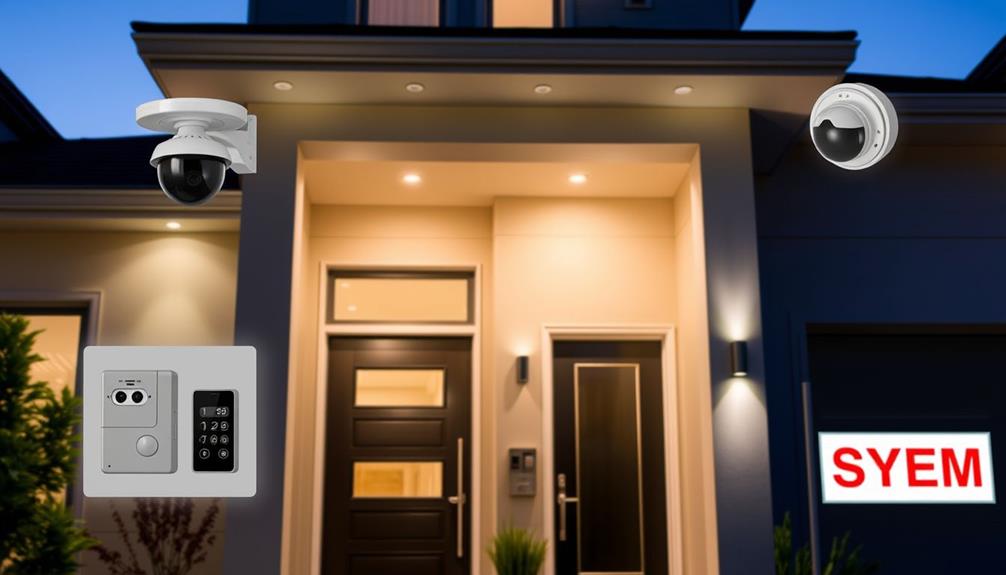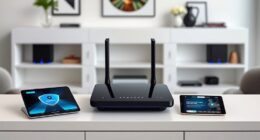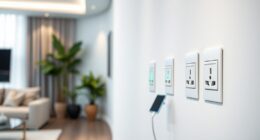To begin setting up your home security system, first assess your specific needs. Identify potential entry points and any vulnerabilities within your home. Then, opt for a DIY system that is within your budget and is capable of connecting to smart devices. Be sure to include essential components such as entry sensors, motion detectors, and environmental sensors. Position the main panel near the main entrance and strategically place sensors throughout your home. Following installation, test each component to ensure they are working effectively. It is important to perform regular maintenance to ensure your system remains alert and reliable. There are many other ways to enhance your home security and explore clever monitoring options that will provide you with peace of mind.
Key Takeaways
- Assess entry points and vulnerabilities to determine the specific security needs of your home.
- Choose between DIY or professional monitoring based on your budget and desired level of surveillance.
- Install essential components like entry sensors, motion detectors, and environmental sensors in strategic locations throughout your home.
- Test each component regularly to ensure functionality and prompt alerts in case of emergencies.
Assessing Your Security Needs
To effectively evaluate your security needs, start by reviewing your home's primary entry points, since many burglaries occur through unlatched doors and windows. Focus on securing these areas, as 30% of burglars take advantage of them.
Additionally, consider investing in advanced security features such as smartphone connectivity and security alerts that can further enhance your home's security.
Next, consider the crime rate in your neighborhood; homes without security systems are 300% more likely to be targeted. This statistic underscores the importance of implementing effective security measures.
Identify any specific security vulnerabilities in your home. Ground floor windows and higher floor bedroom windows might require additional protection. Evaluate the value of items stored in outbuildings as well; if they're significant, you may need extra security.
Once you pinpoint these vulnerabilities, think about the best placement of sensors and cameras for thorough coverage. Strategically positioning these devices can deter burglars and enhance your overall security.
You'll want to verify that all entry points are monitored effectively, reducing the risk of unauthorized access.
Choosing a DIY System

Once you've assessed your security needs, selecting the right DIY home security system can greatly enhance your protection while fitting your lifestyle and preferences. Start by deciding if you want a self-monitoring option or professional monitoring. This choice impacts your peace of mind and response capabilities.
Additionally, compatibility with smart home devices like Amazon Alexa or Google Assistant can elevate your system's functionality. Consider the initial investment, as DIY home security systems range from about $60 to over $400, often with monthly fees for cloud storage or monitoring.
Look for systems that are easy to install and allow for expandability. Many come with user-friendly guides, making setup a breeze. Prioritize essential features such as camera resolution—aim for at least 1080p—and environmental sensors like smoke and carbon monoxide detectors for thorough coverage.
Here's a quick summary to help you choose:
| Feature | Considerations |
|---|---|
| Monitoring Type | Self-monitoring vs. professional |
| Smart Device Compatibility | Integration with existing devices |
| Initial Investment | Costs ranging from $60 to $400+ |
Key Components Overview

When setting up your home security system, you need to understand the essential security elements that will keep your home safe.
Consider how different components work together and guarantee they're compatible with each other to create a seamless system.
For instance, just as you'd seek what to look for in a home cleaning service to guarantee reliability and effectiveness, it's vital to choose security devices that integrate well with your overall strategy.
This way, you can customize your setup to fit your specific needs and budget effectively.
Essential Security Elements
A home security system relies on several essential components that work together to protect your property and guarantee your peace of mind. Understanding these key elements will help you make informed decisions about your security needs. Here's a quick overview of the important components:
- Entry Sensors: These devices detect the opening of doors and windows, alerting you to any unauthorized access. Integrating these sensors with a <a target="_blank" href="https://bestheatpumpro.com">highly efficient system</a> can further enhance your home's security.
- Motion Detectors: Placed in strategic locations, motion detectors monitor movement within your home and are often paired with security cameras for enhanced surveillance. A thorough approach to security, including the use of advanced technology, can considerably improve your home's safety.
- Environmental Sensors: This category includes smoke detectors, carbon monoxide detectors, and water leak sensors, providing essential alerts to hazards such as fire, toxic gases, and flooding.
Home security devices can be customized to fit your lifestyle and budget, ensuring you get the best protection possible. By incorporating these essential security elements, you're taking proactive steps to safeguard your home and loved ones. Investing in a robust security system not only deters intruders but also keeps you aware of potential environmental threats. With the right combination of features, you can create a safe and secure living environment.
Component Compatibility Considerations
Selecting compatible components is important for creating an effective home security system that meets your specific needs. When diving into DIY home security, make certain the main panel supports all desired entry sensors, motion detectors, and environmental sensors. This cohesion is essential for seamless operation.
To enhance your understanding of architectural solutions, consider exploring exclusive design insights available through newsletters that feature thought-provoking articles and case studies.
Many popular systems, like Ring and SimpliSafe, limit their component compatibility to branded products, which can restrict your customization options. If you're choosing security cameras, go for ones with at least 1080p resolution to guarantee clear video quality, and make sure they integrate smoothly with your main security system.
Smart locks are another crucial element; they should connect with other devices, enabling remote access and control via a unified mobile app.
Additionally, if you opt for wireless systems, verify that they're compatible with your Wi-Fi network. You'll also want to check compatibility with other smart home devices to make certain everything functions effectively.
Installation Steps

When you're ready to install your home security system, start by selecting the best location for the main wireless panel near your primary entry door.
Consider the influence of your surroundings on the overall security, as a serene environment can enhance your sense of safety, much like the calming effects of cottagecore aesthetic in home design.
Make certain to position entry sensors and motion detectors according to the instructions for ideal coverage.
Selecting Installation Location
To guarantee your home security system functions effectively, choose an installation location for the main control panel near a primary entry door and a power source. This provides easy access and ideal functionality.
Once you've settled on the control panel's spot, consider the following for placing your sensors: Additionally, engaging with professionals can provide insights on customized architectural solutions that enhance security features. It's crucial to evaluate the layout of your home to determine the best sensor placements for thorough coverage.
- Entry Sensors: Install these on all doors and windows to secure key entry points.
- Motion Detectors: Position them in suitable locations, such as hallways and living areas, to cover larger spaces.
- Environmental Sensors: Follow the installation manual guidelines for smoke detectors and carbon monoxide detectors to verify they're placed correctly for maximum effectiveness.
Testing System Functionality
After installation, you'll want to systematically test your home security system to verify every component functions as intended.
Begin by consulting your owner's manual for specific testing instructions. Start with the entry sensors; open and close each door or window to confirm the system registers the activity correctly.
Next, walk through areas monitored by motion detectors to ensure they trigger alerts and notifications as expected.
Don't forget to test the main panel. Enter your designated access code to verify that it responds appropriately and allows you to arm and disarm the system without issues.
For environmental sensors, regularly check your smoke detectors and carbon monoxide detectors. Use their test buttons to confirm they're operational and alerting as intended.
Each of these steps is crucial in testing system functionality, verifying your alarm sensors and other components work together seamlessly.
By taking the time to perform these tests, you'll have peace of mind knowing your home security system is fully functional and ready to protect your home.
Ensuring Proper Component Placement
Guaranteeing the proper placement of your components is vital for maximizing the effectiveness of your home security system. By strategically positioning your sensors and devices, you enhance your home monitoring capabilities. For example, just as with the effectiveness of dental appliances, proper placement in a security system can greatly improve its performance.
Here's what you should focus on:
- Main Panel & Entry Sensors: Install the wireless security system's main panel near your primary entry door and a power source. Place entry sensors on all doors and accessible windows, making sure they're at a height that allows for effective detection.
- Motion Detectors: Position motion sensors in high-traffic areas, ideally facing potential entry points. This setup helps monitor movement efficiently while reducing false alarms caused by pets.
- Environmental Sensors: Install environmental sensors, such as smoke and carbon monoxide detectors, on every floor and in key areas like kitchens and near bedrooms for maximum safety.
After installation, it's vital to test components according to the owner's manual. This guarantees everything functions properly before finalizing the setup.
While you can do it yourself, consider professional installation for a thorough approach to your home security system.
Testing Your System

Regularly testing your home security system is essential for keeping it in top working condition and guaranteeing your peace of mind. To do this effectively, you should regularly test your system at least once a month, following the owner's manual guidelines.
Start by verifying sensors—check that entry and motion detectors are operational by simulating breaches, like opening doors or walking in front of motion sensors.
Next, test alarm features to guarantee the siren activates and is loud enough to alert neighbors or deter intruders. Don't forget to check the connectivity of your wireless components. Move them to different locations and confirm they maintain a stable connection with the main panel.
Additionally, make it a point to perform firmware updates on your system. This guarantees you benefit from the latest security features and improvements, as outdated software can create vulnerabilities.
Environmental Sensors Importance

Environmental sensors play an essential role in enhancing your home's safety by providing early detection of hazards like smoke, carbon monoxide, and water leaks. These sensors are critical for preventing hazardous situations that could lead to severe property damage or even loss of life. Here's why you should prioritize them:
- Smoke Detectors: Install smoke detectors on every floor and in key areas like kitchens and hallways. This guarantees thorough coverage and quick alerts in case of fire.
- Carbon Monoxide Sensors: Place carbon monoxide sensors near sleeping areas. Since CO is colorless and odorless, early detection is important to avoid serious health risks.
- Water Leak Sensors: Install water leak sensors in flood-prone areas, like basements. They can detect leaks early, preventing costly water damage and mold growth.
Regular maintenance and testing of these environmental sensors are important. Verify they function properly when needed to enhance your home safety.
Monitoring Options and Resources
When it comes to monitoring your home security system, you have several options to choose from, each offering unique benefits for your safety and peace of mind.
One popular choice is professional monitoring, which provides 24/7 surveillance and emergency response for a monthly fee ranging from $10 to $50. These services often include features like video storage and alert systems that notify you of any suspicious activity.
Alternatively, self-monitoring is a viable option, especially with many DIY home security systems available today. With self-monitoring, you can use mobile apps to receive alerts directly on your phone, giving you control over your home security without the added monthly fees. Many of these DIY systems also offer subscription plans that provide enhancements such as cloud storage for video footage.
Regardless of the monitoring option you choose, regular testing and maintenance of your system are vital. Ensuring everything functions properly will help you receive alerts promptly in emergencies.
Ultimately, selecting the right monitoring option is essential for creating an effective home security solution tailored to your needs.
Frequently Asked Questions
Can I Install a Home Security System Myself?
Yes, you can install a home security system yourself. Many DIY options are user-friendly, so you can customize your setup easily. Just follow the guidelines, test everything, and you'll be well-protected.
How to Set up a Security System at Home?
To set up a security system at home, choose a central location for your main panel, install entry sensors on doors and windows, place motion detectors strategically, and test everything thoroughly to guarantee proper functioning.
What Is Required for a Home Security System?
Picture a vigilant knight protecting your castle. For your home security system, you'll need a control panel, entry sensors, motion detectors, environmental sensors, and a reliable power source to guard against unwanted intruders and hazards.
Where Do I Start With Home Security?
Start by evaluating your home's vulnerabilities, especially doors and windows. Decide between DIY or professional systems, then invest in essential components like sensors and cameras. Finally, review your budget for ongoing costs.
What are the Essential Components of a Home Security System?
When building a home security system, there are essential components to consider. These include surveillance cameras, motion sensors, door/window alarms, and a control panel. Additionally, a reliable monitoring service and smartphone integration can enhance the system’s effectiveness. It’s important to choose quality components to ensure maximum protection.
Conclusion
In the end, investing in a home security system is like locking the barn after the horse has bolted; it's best to act before an incident occurs.
By evaluating your needs and choosing the right components, you can create a system that offers peace of mind.
Don't forget to test it regularly and stay informed about monitoring options.
With the right approach, you'll keep your home safe and secure, ensuring your loved ones are well-protected.









